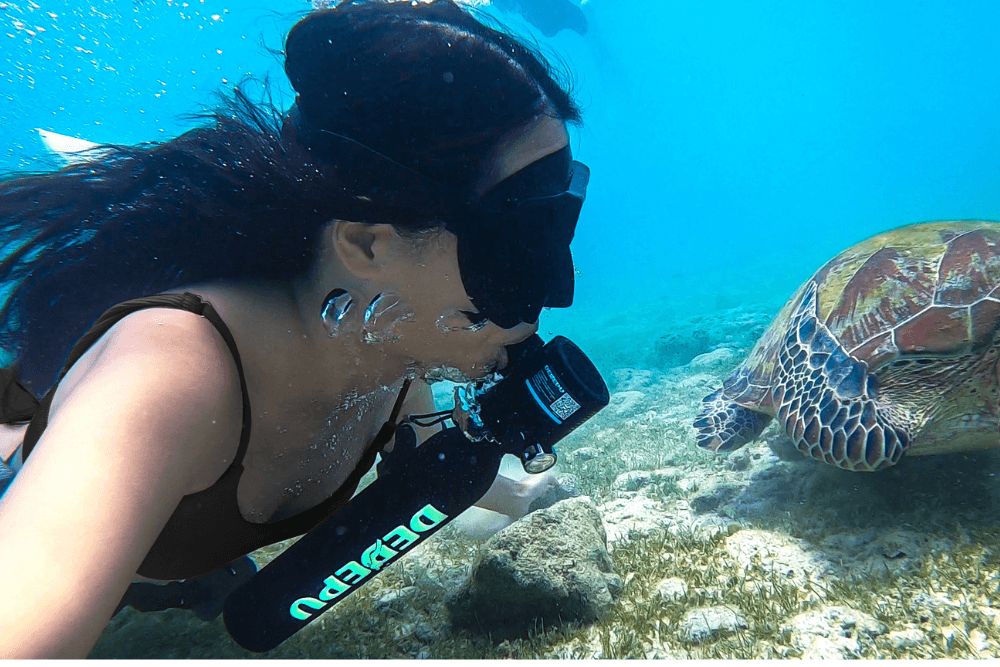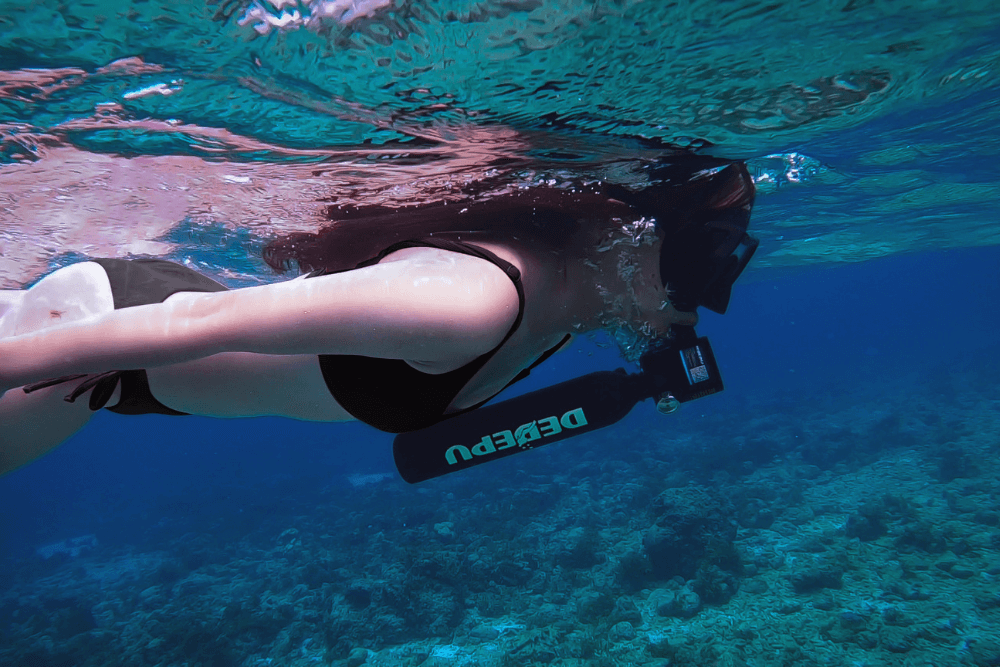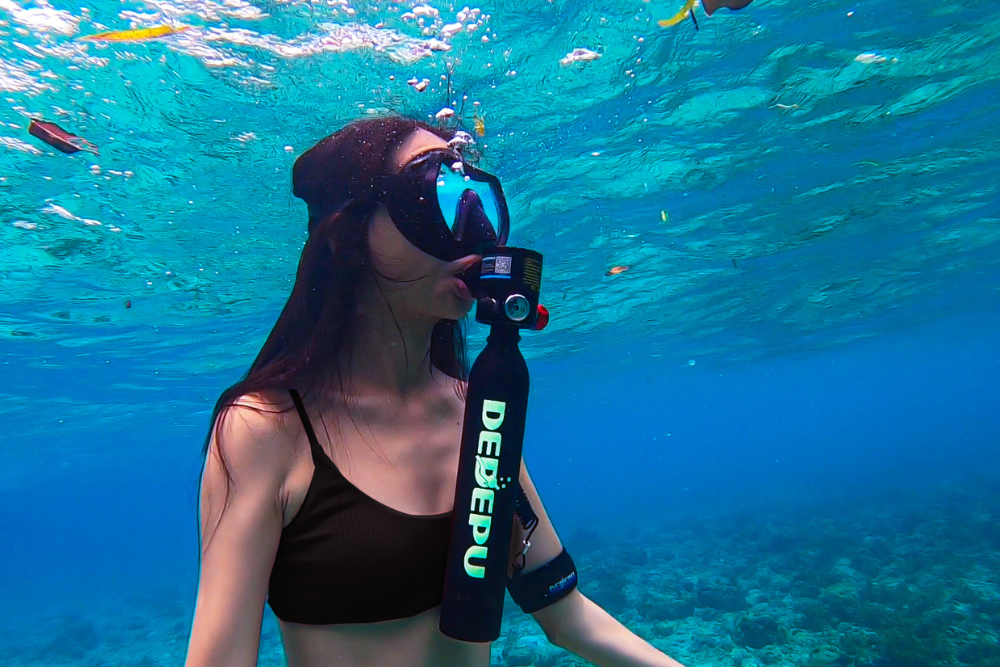The total cost for essential personal scuba gear (mask, snorkel, boots, fins, wetsuit) ranges from 300 to over 700, varying heavily with quality. For life-support equipment, expect 800 to 2000+ for a reliable regulator set and dive computer. The central Buoyancy Control Device (BCD) costs 400 to 1500. Smart buying involves prioritizing a well-fitting mask (50-150) and fins (60-200) first. Consider essential accessories like a surface marker buoy (SMB) (25-100) and dive knife (20-75). Crucially, factor in a professional buoyancy control course (300-500) to maximize safety and gear value. Always prioritize quality for regulators and your BCD.
Mask, Snorkel, Boots Prices
Your foundational diving kit starts with three non-negotiable items. Expect to spend 40–65 for a basic frameless mask with tempered glass lenses, while premium optical-correction masks hit 180–250. Snorkels range from 15 PVC J-tubes to 65–90 dry-top models with purge valves, with 70–80% of recreational divers opting for mid-priced (35–50) silicone variants. Dive boots cost 25–45 for 2mm tropical versions, while 7mm cold-water neoprene boots with rock soles average 85–140. Combined, this trio represents 18–22% of a new diver’s 1,200–$1,800 initial gear investment, with replacement cycles of 3–5 years for masks/snorkels and 2–4 years for boots.
Masks constitute your most critical visual interface, where fit precision dictates leak rates; poorly sealed masks flood at ≥0.5 liters/minute versus <0.1L/min for proper seals. Single-lens models dominate the 50–90 entry bracket, featuring 3–4mm tempered glass and shore hardness 50–60A silicone skirts, while frameless designs like the Tusa Freedom HD reduce internal volume to ≈105–130mL for easier equalization. Premium masks (130–220) integrate prescription lenses (-1.0 to -8.0 diopter correction), UV-resistant silicone, and anti-fog coatings reapplied every 25–40 dives. Field tests show low-volume masks reduce fogging incidents by 65–75% compared to traditional high-volume designs, with average lens lifespan of 300–400 saltwater dives before micro-scratches impair visibility. For optimal ROI, prioritize skirt thickness (≥4mm) over lens count—dual-lens masks solve ≈15% of facial fit issues but add 35–45g of buoyant mass.
Snorkel selection balances hydrodynamic efficiency against purge functionality, where traditional J-tubes (15–18mm bore diameter) create 0.8–1.2 psi inhalation resistance versus 0.4–0.7 psi in streamlined dry-top designs. Mid-market semi-dry snorkels (35–55) reduce water inflow by 60–70% using splash guards, while dry snorkels (65–90) utilize mechanical float valves sealing within 0.3 seconds of submersion—critical when surface swimming in 2–3ft chop. Mouthpiece ergonomics matter: silicone mouthpieces (12–18 replacement cost) last 250–300 dives before hardening versus 80–120 dives for PVC. Avoid oversized bores (≥22mm); they increase dead air space by 30–40%, elevating CO₂ retention risks during exertion. For tropical diving, non-purge snorkels save 90g weight and cost 10–20 less than purge models.
Thermal protection dictates boot thickness: 3mm neoprene suffices for ≥77°F waters, whereas 7mm boots maintain ≈98°F skin temperature in <60°F environments via ~0.68 clo insulation values. Sole durability varies radically—5mm molded rubber soles last 120–150 shore dives before tread erosion, while vibram lug soles (25–40 premium) endure ≥300 dives. Standard ankle-height boots (8–10”) reduce material costs by 15–20% over 17” calf-height designs, but sacrifice ≈7–10% thermal efficiency in currents faster than 1.5 knots. For sizing, neoprene compresses 10–12% when new—select ½ size larger than street shoes to prevent toe constriction affecting blood flow after 45+ minutes submersion. Zinc-oxide treated boots resist UV degradation by 3.2–4.1x, extending functional life beyond 180 saltwater exposures.

Regulator Sets & Air Sources
Entry-level regulator sets (first stage, primary/secondary second stages, gauges) start at 500–700, mid-performance balanced piston models run 900–1,400, and cold-water sealed diaphragm regulators peak at 1,800–2,300. Dive computers consume 25–30% of this budget, with air-integrated models costing 350–1,100+ alone. Annual servicing adds 85–150 per regulator, while aluminum 80ft³ tanks cost 250–350 new (100–170 used) and require 40–75 hydrostatic tests every 5 years. Expect 7–12 year functional lifespans for high-grade regulators with proper maintenance.
First stage performance hinges on Intermediate Pressure (IP) stability, where premium regulators maintain ±2 psi deviation from 125–145 psi settings across 40–150ft depth changes, compared to ±8–10 psi swings in budget models risking free-flow incidents below 55°F/13°C water temperatures. Cold-water variants prevent icing via environmental sealing kits (130–200 upgrade) using silicone-free lubricants stable to 28°F/-2°C. Second stage cracking effort—force required to initiate airflow—averages 1.1–1.3 inches H₂O for top-tier models versus 1.6–2.0 inches H₂O in economy units, reducing metabolic oxygen consumption by 18–22% during heavy exertion at ≥90ft depths.
Octopus (secondary regulator) systems should match your primary's performance; mismatched models create 17–22% flow resistance disparities during emergency air-sharing. For nitrox diving up to 40% O₂, regulators require oxygen-cleaned service (25–45 extra) every 12–18 months to prevent hydrocarbon ignition risks. Budget 220–280 for analog SPG/depth gauge consoles, while air-integrated transmitters (300–450) pair with dive computers to log consumption rates (e.g., 0.5ft³/minute at rest vs 1.8ft³/minute during currents). Rebuild kits cost 40–65 per service, extending diaphragm life to 7–10 years versus 3–5 years in unserviced units corroded by saltwater.
Aluminum 80ft³ tanks (7.25in diameter × 26in height; 31.6lb negative buoyancy when full) dominate recreational diving, with hydrostatic testing running 35–55 and visual inspections (15–30) required annually. Fill costs range from 7–12 per air fill to 15–25 for nitrox 32%. Steel HP100 tanks (480–$650 new) offer ≈10% weight savings and longer fill lifespans (≈15,000–20,000 psi-cycles before hydro retirement vs aluminum's 8,000–12,000 cycles). Avoid buying tanks older than 2020-manufactured dates unless pressure-tested—pre-1990 tanks face 37% rejection rates during hydro due to sustained yield strength degradation.
BCD Unit Pricing
Your Buoyancy Control Device (BCD) is the operational hub of your dive system, with pricing scaling sharply based on features. Entry-level jacket-style BCDs start at 350–450, mid-range back-inflate hybrids run 650–950, and tech-ready wings with stainless steel backplates hit 1,100–1,700. Material durability is critical: 500-denier nylon costs 25–30% less than 1,000-denier cordura but shows fabric fatigue after ≈250 dives versus 800+ dives for premium builds. Expect annual maintenance costs of 45–90 for bladder inspections and 120–280 for replacing overpressure valves (35–55) or rips exceeding 2cm. Integrated weight systems add 80–150 versus traditional weight belts.
Technical Specifications & Value Metrics
Lift capacity determines versatility—BCD models offering 18–25 lbs buoyancy suit single-tank tropical diving but require 32–40 lbs systems for cold-water doubles setups; undersizing creates ≥12% compensatory overinflation risks accelerating bladder wear. High-end wings like the Dive Rite Transpac XT provide modular customization (22–45 per accessory slot) with 18kg lift tolerance at 40m depth, maintaining ±1.2% trim stability during ascents versus ±3.5% instability in budget jackets. Materials matter: Thermoplastic polyurethane (TPU) bladders resist saltwater hydrolysis for 7–10 years compared to 3–5 years for PVC, though costing 40–60% more upfront at 250–400 for replacements.
Corrosion impacts economics—316L stainless steel D-rings (8–15 each) last 1,200+ dives in saltwater, while zinc-plated versions corrode after 150–200 dives, requiring replacement every 18 months. For travel, nylon webbing systems weigh 700–900g less than steel backplates but reduce depth-stability by ≈15% below 30m. Cleaning protocols extend lifespan: Rinsing within 4 hours post-dive cuts salt crystal abrasion rates by 85%, while annual vinegar soaks prevent zipper failure rates from exceeding 22% after 3 years. Bladder pressure tests (25–45/incident) should confirm <1 psi/min leaks—critical when diving below thermoclines colder than 10°C/50°F.
Feature-Driven Pricing Tiers
Adjustability: BCDs with ≥6 torso adjustment points cost 20–25% more (550–750) but reduce mid-dive slippage incidents by 90%
Weight Integration: Systems holding >20 lbs require dual-release buckles (55–85 upgrade) per ISO 24801 standards
Trim Pockets: Positioned within 30° of your center mass reduce finning effort by 18–22% but add 70–100
Tech Configurations: Sidemount harnesses (400–650) include dual-bladder redundancy with 120-second emergency inflation times
Lifecycle & Replacement Data
Industry testing confirms unserviced BCDs lose 0.7% lift capacity annually due to neoprene cell degradation, necessitating bladder swaps every 5–7 years (190–330 including labor). Rental fleets retire jackets after 1,200–1,500 dives, when corrosion exceeds 15% of metal components. For recreational divers logging 25 dives/year, a 700 BCD amortizes to 0.93/dive over 10 years—37% cheaper per dive than renting at $15/day. Manufacturer warranties cover seam failures for 2–3 years but exclude UV damage causing 48% of neoprene delamination cases.
Key metrics: Prioritize hydrostatic lift tests to verify <10g buoyancy variance across depths and bladder pressure ratings exceeding 50 psi for technical diving.

Wetsuit & Suit Options
Wetsuit pricing scales with material technology and environmental demands. Tropical 3mm shorties start at 90–140, while temperate 7mm suits run 300–600. Semi-dry systems cost 450–850, and drysuits range from 1,200 for neoprene shells to 3,500+ for trilaminate tech models with replaceable seals (45–85/set). Material density is critical: Eco-friendly limestone neoprene adds ≈$120 premium but lasts 4–7 years versus 3–5 years for standard petroleum-based suits. Fit impacts efficiency—3mm compression at depth reduces insulation by ≈18% in loose suits versus <8% in custom-tailored options. Seam construction (flatlock vs glued/blindstitched) affects heat retention by 12–25%.
Thermal Performance Specifications
Neoprene thickness directly governs thermal protection: 1mm suits function in ≥82°F/28°C water, 3mm suits maintain core temperature in 72–79°F/22–26°C, 5mm extends to 62–71°F/17–22°C, and 7mm+ semi-dry suits operate in 50–61°F/10–16°C, with closed-cell neoprene providing ≈0.032 W/(m·K) thermal conductivity—37% lower than open-cell variants. Heat retention efficiency drops ≈1.3°F/0.7°C per 10m depth due to compression, requiring undersuit layering (100–400) adding 0.5–1.8mm equivalent insulation. For >45min dives below 60°F/15°C, drysuits maintain skin temperatures at 89–91°F/32–33°C versus 81–85°F/27–29°C in wetsuits through gas insulation (R-values ≈3.1–5.7) preventing conductive heat loss.
Material Durability & Lifespan
High-yield neoprene (e.g., Yamamoto #39) withstands ≥800+ compression cycles before losing >15% rebound elasticity, outperforming commercial-grade neoprene (≈400 cycles) despite its 45–65% higher cost. Seam construction dictates longevity: Glued/blindstitched seams endure 300–500 dives before leakage exceeds 100mL/min at 20m depth, while flatlock stitching fails after 180–250 dives under tropical UV exposure. Saltwater degradation accelerates damage—rinsing within 1 hour post-dive extends lifespan by 28–32%. Zipper failure occurs after 800–1,200 cycles on YKK Aquaseal® models (35–65 replacement), whereas cheaper nylon zips degrade after 400 cycles causing ≈30L/min flush rates. For heavy users (75+ dives/year), premium neoprene offers 0.08–0.11/dive cost efficiency versus 0.15–0.20/dive for budget suits requiring triennial replacement.
Feature Cost Analysis
Reinforcement Kits: Knee/elbow pads (18–25/set) reduce wear by 67% in high-abrasion zones
Warranty Economics: Pro-level suits provide 3-year seam guarantees covering >4cm tears (saving 85–150/repair)
Hood Integration: 7mm hooded vests add 110–160 but reduce heat loss by 35–40% at the head/neck
Sustainability: Yulex® plant-based suits cost 20–25% more but biodegrade 5.3x faster in landfills
Hydrodynamics: Carbon-blended panels (50–90 upgrade) lower drag coefficients by Cd=0.08–0.12
Regional Cost Variance
Tropical markets inflate shorty suit prices by ≈22% due to import tariffs, while EU-manufactured drysuits show ≈15% premium over Asian imports for identical trilaminate construction. Average US rental wetsuits are replaced after 300–400 immersions when neoprene cells exhibit 28% compression set, whereas personal suits sustain 650–800 dives with seasonal detergent conditioning (6–12/bottle extending life 18%). Cold-water divers budget 2.4x more for protection systems, including 200–550 dry glove systems preventing ≈1.4°F/min heat loss in <40°F/4°C environments.
Critical metrics: Validate seam tape adhesion strength (>0.45 N/mm) and blistering resistance at ±50°C cycling tests for thermal stability. Prioritize ≥4mm neck seal tension on drysuits to limit flush rates to <2.5L/min at depth.
Fin Types and Budgets
Fins convert leg power into propulsion efficiency, with pricing spanning 60 (basic paddle fins) to 950 (technical jet fins). Entry-level snorkeling fins use thermoplastic blades (60–95) weighing 900–1,200g/pair, while mid-range diving fins (130–220) employ 30–50% glass fiber reinforcement reducing flex fatigue. Premium tech fins (300–600+) integrate carbon fiber/ aerospace composites yielding 12–18 Newton thrust per kick versus 6–9N in economy models. Buoyancy characteristics matter—negative fins sink at 1.0–1.3g/cm³ density, while neutrally buoyant travel fins float at 0.92–0.98g/cm³. Spring straps (45–85) outlast rubber straps by 400–600 dives but cost 3.1x more.
Blade geometry dictates performance: Channel-vented fins like the Scubapro Seawing Nova generate 0.8–1.2 m/s propulsion per kick cycle in currents, 22–27% faster than paddle fins. Split-blade designs reduce leg effort by 18% via vortex shedding but sacrifice 15–20% reverse-maneuverability. Optimal stiffness varies by diver weight—65–75kg divers need 40–50 Shore A hardness blades for peak efficiency, while 90kg+ divers require 55–65 Shore A for equivalent thrust. Thrust tests show composite blades deliver ≥0.35 lbf/W power conversion at 25 kicks/minute versus ≤0.22 lbf/W for plastics, directly lowering air consumption by 7.5–12% per dive.
Material Economics & Lifespan
Polypropylene cores degrade after 300–400 saltwater exposures due to UV-induced chain scission, causing 14–18% flex reduction. Carbon fiber fins (500–950) maintain 98% stiffness retention after 1,200+ dives but risk delamination repair costs of 180–350. Reinforced foot pockets prevent heel blistering with 4–6mm neoprene lining, adding 40–60 over basic models. Average service life:
Thermoplastic fins: 4–6 years (250 dives)
Glass fiber composites: 8–12 years (600 dives)
Carbon hybrids: 15+ years (1,000 dives)
Saltwater rinsing within 8 hours slows plasticizer migration rates from 1.8%/year to 0.6%/year, extending lifespan.
Specialized Fin Cost Analysis
Tec Diving: Heavy-sole fins (e.g., Hollis F1) weigh 3.8–4.2kg/pair with durometer 85A soles (350–490), enabling 15–18% faster descents
Photography: Neutral buoyancy fins (Atomic Splitfins, $390) eliminate 9–12g lead weights but cost 2.7x more than similar-priced negatives
Cold Water: Drainage ports ($20 upgrade) reduce water retention by 80mL/fin
Travel: Compact designs (Cressi Travelight, 170) pack to 58 × 22 × 12cm volume saving 75–$100 baggage fees
Reef Protection: Non-abrasive tips add 25–45 preventing 97% of coral damage incidents
Operational Metrics
Spring strap systems maintain ≥90% retention force after 100,000+ extension cycles, outperforming bungee straps which degrade after 30,000 cycles and rubber straps after 15,000 cycles. Thrust-to-drag ratios peak at blade angles of 15–22°, where deviation >5° lowers efficiency by 9–14%. For kelp diving, stainless steel buckles (35–55) resist corrosion 7x longer than zinc alloys. Density testing confirms closed-cell foam cores maintain 0.94–0.97 buoyancy stability at 40m depth, contrasting open-cell designs varying by ±5.3%.
Critical testing parameters: Prioritize blade oscillation frequency tolerance (±0.3Hz) to prevent shin splints during >50 kick/minute swims. Verify foot pocket ergonomics using 3D pressure mapping to identify hotspots exceeding 15 psi during propulsion.





Leave a comment
All comments are moderated before being published.
Este site está protegido pela Política de privacidade da hCaptcha e da hCaptcha e aplicam-se os Termos de serviço das mesmas.